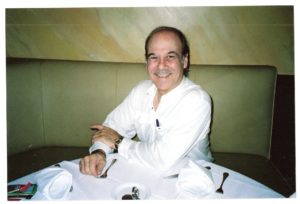A Special Moment In Time: Ida And Isidor Cohen
[AdSense-A]
There are so very many revered names in the history of Greater Miami, from the Weiss family of Joe’s Stone Crab Restaurant to the Galbut family of Miami Beach, to the Traurigs and the Hechts (Flagler Dog Track) and the Pallots, Julia Tuttle, Mary and William Brickell, Everest and John Sewell, Carl Fisher, Collins and Pancoast, the Lummus Brothers….suffice to say, the list borders on nearly endless, but among all of them, the patriarch of historical Jewish Miami is and will forever be remembered as the revered Isidor Cohen.
It was through Cohen’s granddaughter that the greatest single collection of Miami Jewish history was bestowed upon me, and that story, in and of itself, is not only fascinating but bears telling here, for Isidor Cohen arrived in the budding city-to-be, excitedly awaiting the arrival of the recently renamed Florida East Coast Railway, on February 6, 1896. Cohen was here to greet the arrival of the first passenger train of that great and fabled railway on April 22, 1896, getting to meet, among others, Henry M. Flagler, James E. Ingraham (for whom the Ingraham Building in downtown Miami is named) and Joseph R. Parrott, Mr. Flagler’s railroad vice president.
The story of how the collection came to be part of The Bramson Archive is fascinating in and of itself, and is today part of this area’s local historical lore, for it was sometime in early 2007 that I received a phone call, a pleasant female voice on the other end of the line.
“Mr. Bramson?” “Yes?” “Hi, my name is (and we will leave out the names because of issues of privacy, to which the family is certainly entitled) and I understand that you are interested in memorabilia.” Without even knowing what the “memorabilia” was, I immediately responded in the affirmative.
“Well,” she said, “I have some material that you might be interested in. Would you mind coming over to see it?” Needless to say, the answer was a without hesitation warmly stated “not at all; happy to do so.” And with that, an appointment was made, a day, date and time set, and at the appointed hour I was warmly greeted and ushered into a lovely home.
As we walked into the dining area, I noted seven large plastic storage boxes on the table, on the chairs and on the floor and I somehow insightfully garnered the idea that the memorabilia might be in the boxes.
She again referred to me as “Mr. Bramson,” at which point I corrected her, as I do anybody who is gracious and cordial: “My students call me ‘Mr. Bramson’ or ‘Professor Bramson,’ my friends call me ‘Seth.’” To which she replied, “That is so nice, Seth.” “Do you know who I am?” I thereupon responded that I knew where she was employed and what her husband’s occupation was, at which point she smiled warmly and asked me, “but do you know who I really am?!!” Suffice to say, I was caught completely off guard. “Why, no, (her name), I only know what I just told you.” And then, following that remark, she stunned me beyond words. “Seth,” she said, casually and off-handedly, “my grandfather and grandmother were Isidor and Ida Cohen.”
At that moment, besides being startled and speechless, I felt my knees weaken and my pulse quicken, for I suddenly had some thought as to what might be in the boxes.
“We have been having, for several months, on ongoing family discussion. You know, for many years, any time anybody in the family was going to throw something away I always said, ‘no, don’t. Our family is very important to Miami’s history and we should keep it. So they always told me that, if I wanted it saved, it would have to be saved in my house.’ ” By now, I was perspiring, realizing who I was with and what was in the boxes: it was Miami’s Jewish heritage and I was standing with a direct descendant of Isidor and Ida and in the boxes that I was staring at was that heritage.
“The problem,” she stated, “is that our children our grown, we don’t need a house this large and we are getting ready to move. We need to place these boxes in a place where they will be treasured and revered.”
And then came the bombshell: “Seth, for some months we have been having an ongoing family discussion. Do we give the collection to the Jewish Museum, to the Historical Museum or to the Bramson Archive?” And, with my pupils dilating, my legs close to collapse, my eyelids fluttering involuntarily, I knew she hadn’t invited me to her home to tell me that they were giving the collection to the museums; I knew then that it was going to wind up where it should and where it belonged: in The Bramson Archive.
Continuing, she noted that, “if we give it to one of the museums, we know that we will get a lavish letter of thanks and then it will all go into a basement, never to be seen again, but if we give it to the Bramson Archive, we know it will be shared with the community.”
Suffice to say, for the moment and in conclusion for this edition, that thanks to my acquisition of the Cohen collection, “L’Chaim! The History of the Jewish Community of Greater Miami” was published by The History Press, of Charleston (www.historypress.net) in 2008 and was the first-ever history of the Jewish people in Greater Miami, remaining today the best-selling book on Miami-Dade’s Jewish heritage ever published.
Next week: Isidor and Ida Cohen, Part Two: Who They Were and What They Did,
[si-contact-form form=’2′]


